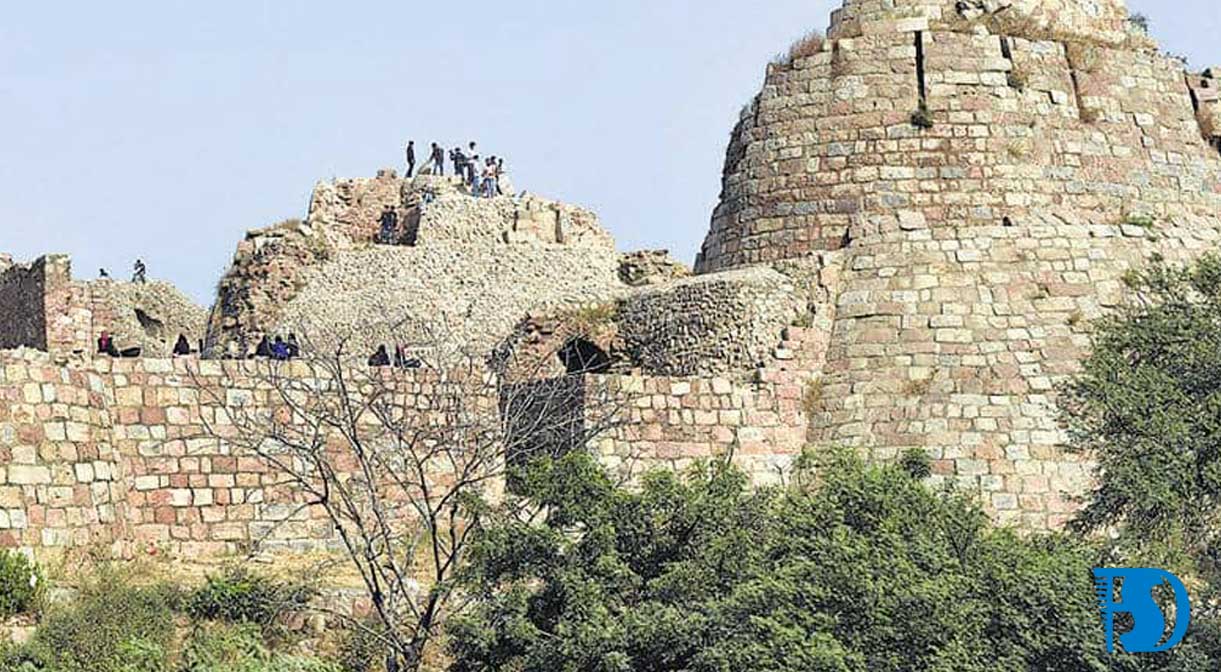
Tughlaqabad Fort is a fort destroyed by Delhi. This fort, spread over 6 km, was built by the founder of the Tughlaq Empire, Ghasuddin in 1321 in the Delhi Sultanate. But in 1327 they had to relinquish it.
The area around it is also known as Tughlaqabad local area. Tughlaq also constructed the Qutub-Badarpur road along this fort, which connects the new city with the Grand Trunk Road. This road is also known today as Mehruli-Badarpur road.
Curse of Nizamuddin Auliya (curse):
Ghasudin was known as a generous ruler. While he used to be more enthusiastic about the kilo that he saw in his dream. Because of this, he also issued a decree that all the workers of Delhi will work in the same fort.
With this Sufi saint Nizamuddin Auliya got angry, because the work being done in his well was stopped after this order.
After this, the saint pronounced the curse, whose effect is seen from history to this day: Yarheyuzar, Yabseaguzar means that "the people here will live here and only Gujjar will rule here."
It is said that after the fall of the Sultanate, Gujjar had captured this fort and today even Tugalkabad village is inhabited in the fort.
Death of the ruler:
After this, another saint Hanus Delhi Durg had also curse. At that time rulers were engrossed in a campaign of Bengal. In which he got success and then he returned and returned to Delhi.
While his son Muhammad bin Tughlaq got him from Kar in Uttar Pradesh. It is said that only after the order of the Prince, the Emperor's Shamiyana was dropped on him, which led to his death. He died in 1324.
Ghasuddin Tughlaq's Samadhi:
Ghasudin Tughlaq's Samadhi is associated with a paved road near the Durg's Southern Chowk. This paved road is 600 feet long, supported by 27 arches. It is said that in the 20th century, some part of this paved road was converted into the Mehrauli-Badarpur road.
After crossing the ancient peepal tree, there is a large entrance gate of Ghasudin Tughlaq, which is made from red stone.
The actual Samadhi of Ghasuddin has been made in the shape of a single domed square Samadhi, whose sloping walls are crowned by guardrail.
It is said that the walls of Samadhi have been constructed from granite and the edges of Samadhi have been decorated with red stones and marbles have also been used to decorate it.
There are three graves inside his Samadhi: the grave of the grave is of Ghasudin and the other two graves are his wife and his son and his successor, Muhammad bin Tughlaq. Another octagonal grave has been constructed in the corridor attached to the Pillaro on the north-western part of the wall.
A red slab of slabs is also made on its door using small marbles in the same shape.
According to inscriptions written on the door, the grave built on its southern entrance is Zafar Khan. According to sources, Zafar Khan constructed the fort of the fort in a very beautiful way.
Tughlaqabad Fort Architecture:
Tughlaqabad is still famous for a kilo made of huge stones. A lot of historical heritage was built here during the reign of the Tughlaq Empire.
Also, 10-15 meter high curved walls have also been constructed here. According to experts, this city had 52 entrance gateways, of which only 13 survive today. Today only 7 rain water tanks remain in this beautiful and charming city.
Tughlaqabad is divided into three parts:
1. The highest point of the fort built with the tower is the Bijay Mandal.
2. Huge urban terrain was done with a house with a rectangular grid in the middle of its door.
3. While royal people lived in the adjacent palace area of ​​the third part. We still see this part of the tower below.
At present, most of the city is inaccessible due to thick forested vegetation. There are currently plenty of modern people living around the city's lakes.
There is a large artificial water reservoir in the south of Tughlaqabad, where the grave of Ghasudin Tughlaq remains on the paved road. We still see this road connected to the temple's southern outpost.
In the south-eastern part of the fort, we see the fort of Adilabad, which were constructed by his successor, Muhammad Tughlaq (1325-51) of Ghasuddin's death. Within the fort of Tughlaqabad we see many small and important historical heritage.
 Dear Reader, My name is Manisha Dubey Jha. I have been blogging for 3 years and through the Fast Read.in I have been giving important educational content as far as possible to the reader. Hope you like everyone, please share your classmate too. As a literature person, I am very passionate about reading and participating in my thoughts on paper. So what is better than adopting writing as a profession? With over three years of experience in the given area, I am making an online reputation for my clients. If any mistakes or wrong in the article, please suggest us @ [email protected]
Dear Reader, My name is Manisha Dubey Jha. I have been blogging for 3 years and through the Fast Read.in I have been giving important educational content as far as possible to the reader. Hope you like everyone, please share your classmate too. As a literature person, I am very passionate about reading and participating in my thoughts on paper. So what is better than adopting writing as a profession? With over three years of experience in the given area, I am making an online reputation for my clients. If any mistakes or wrong in the article, please suggest us @ [email protected]
Read More.
